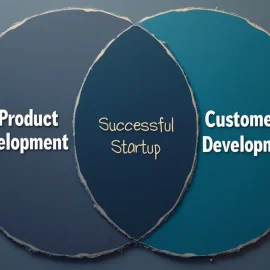

This article is an excerpt from the Shortform book guide to "Obviously Awesome" by April Dunford. Shortform has the world's best summaries and analyses of books you should be reading.
Like this article? Sign up for a free trial here.
Once you’ve created a product positioning plan, what are your next steps? How do you make your plan a reality?
Once you have a positioning strategy, you need to put it into effect. Your positioning implementation plan should involve creating a narrative about your product, building your messaging, and, finally, tracking your success and making any needed adjustments.
Let’s take a look at each step in detail.
Step 1: Narrative
Creating the narrative is the first step in your positioning implementation plan. This is the pitch with which your salespeople will approach prospects. Here’s how to construct the narrative about your product, according to Dunford: First, articulate the problem your product helps the customer solve (“It takes you forever to vacuum your entire office”). Then, explain how other solutions fail to solve that problem (“Most vacuums require frequent emptying and cleaning, which slows you down”). Next, tell the customer what the perfect solution to the problem would be, and then introduce your product by explaining what market it’s in (“You need a vacuum with immense cleaning power, which is why you need the DustDestroyer, the top vacuum for workplaces”). Finally, explain the value the product adds to the customer’s life (“The DustDestroyer lets you clean faster and more efficiently than other vacuums, saving you time”).
| Alternative Marketing Narratives In Building a StoryBrand, Donald Miller presents an alternative marketing narration that helps sell your product to customers: Instead of beginning the story with the problem your product solves, Miller begins the story with the customer’s desire: the state or objective they wish to attain. Next, he advises explaining the customer’s problem, elaborating that the problem can be external (tangible), internal (an unpleasant emotional state), or philosophical (misalignment of the customer’s lifestyle with their values). The narrations continue to diverge in an important way: Dunford’s narration includes an articulation of the value the product adds while Miller’s narration contains a call to action—the ask for the customer to buy. We might imagine Dunford is aware of the foundational importance of the call to action in selling and doesn’t include it in her narrative because it’s not as integral to positioning as communicating the problem to customers and showing them how your product helps solve it. A call to action is more important in messaging to customers because this is where you truly sell the product. This means that when it comes to messaging—which Dunford doesn’t elaborate on—you might consider adding a “call to action” field to your messaging document. This will ensure you actually ask the customer for the sale. |
Step 2: Messaging
Next, have your marketing team adjust the messaging based on the new positioning. Messaging is contained in your marketing to customers. Dunford doesn’t elaborate on how to message because there are other resources to help you do that, but she does recommend creating a messaging document containing the main message, which your team can adjust for each piece of marketing material.
Step 3: Tracking and Adjustments
According to Dunford, the final piece of your positioning implementation plan is to track the success of your positioning over time and make adjustments if needed. Assess your positioning every six months to learn if the market has changed and if you need to thus reposition your product. Possible changes to the market include established competitors entering it, changing government regulations, the introduction of new technology, changing customer desire, and the economic environment.
(Shortform note: How can you stay abreast of changes in your market to ensure your product remains optimally positioned? You might conduct simple research online or keep track of what your competitors are doing. You could also use social media, including LinkedIn, to gauge what’s happening in the market and how customers are feeling. Finally, it may be worth soliciting the input of advisors and going to industry conferences to obtain the insights of leaders to gain a long-term perspective of where your market is headed.)

———End of Preview———
Like what you just read? Read the rest of the world's best book summary and analysis of April Dunford's "Obviously Awesome" at Shortform.
Here's what you'll find in our full Obviously Awesome summary:
- What "positioning" is and why it's so important for marketing
- Three common (and avoidable) mistakes marketers make
- A 12-step process that lets you position any product well






